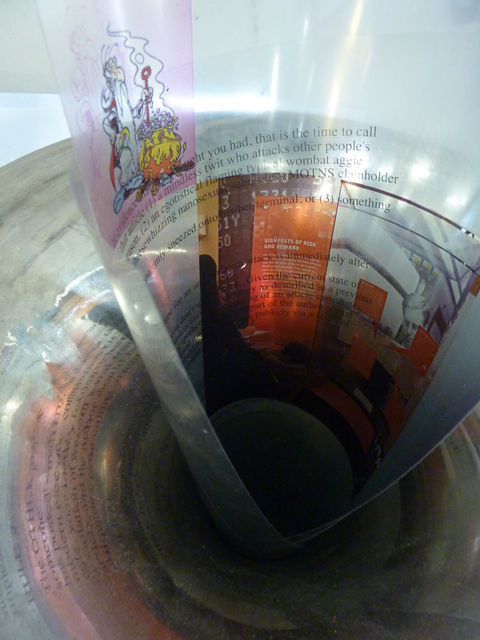David Jablonowski
02 Jun - 21 Jul 2012
DAVID JABLONOWSKI
User
2 June - 21 July 2012
‘A user is an agent, either a human agent (end-user) or software agent, who uses a computer or network service. A user often has a user account and is identified by a username (also user name). Other terms for username include login name, screen name (also screenname), nickname (also nick), or handle, which is derived from the identical Citizen's Band radio term.
Users are also widely characterized as the class of people that use a system without complete technical expertise required to understand the system fully. In hacker-related contexts, such users are also divided into lusers and power users.'[1]
We navigate from one link to the other, browse from one textual fragment or a pixilated image to the newest printer and consume the best and most desirable designs; we tap into their messages; leave our traces and generate new content, exchanging one sign for another. And sometimes, every now and then, we log in to simple physical reality. Are these the signs of our contemporaneity? Or are they perhaps methodological continuations of a long history of artistic reproductions of design – of copy-paste strategies – such as the Medieval manual copying of codices and Arabic and Persian calligraphies?
With its seemingly simple title “user”, David Jablonowski’s first solo exhibition in Galerie Fons Welters raises questions about the persona of this ‘user’. Although Wikipedia – perhaps the representation of the ‘new’ encyclopedic paradigm of interconnected articles through hyperlinks – is quick to give a definition, it says little about who this ‘user’ really is, this human - or software agent, who is at the same time a ‘producer’. Is he/she the personification of the promise of the internet as a transparent society in which ‘user’ and ‘producer’ become one? Or is it rather a new type of consumerism, wherein one gets trapped in the logics and logistics of the hypertext?
In Jablonowski’s exhibition his/her language is juxtaposed to and at the same time merged with the language of the sculptor. He/she is present in the finger traces left on a touch screen and captured in a slide show ; or on delicate aluminum plates combined with a calligraphy, a different, earlier, type of writing ; he/she appears in two video screenings of a.o. Dough Engelbart, internet pioneer and inventor of the computer mouse. By way of an interlude, Jablonowski highlights the work of Michael Corris, of Art & Language, through several of his books, representing a different language strategy.
In David Jablonowski’s sculptural installation a dense tissue of references to and direct physical quotations of our media histories, hardware and software devices, protocols and online marketing strategies are combined with the everyday. The virtual is here captured in and translated to the physical domain, revealing unexpected visual relationships and setting a complex scenography for the exhibition’s main protagonist: the ‘user’.
[Laurie Cluitmans]
___________________________
[1] http://en.wikipedia.org/wiki/User_(computing)
User
2 June - 21 July 2012
‘A user is an agent, either a human agent (end-user) or software agent, who uses a computer or network service. A user often has a user account and is identified by a username (also user name). Other terms for username include login name, screen name (also screenname), nickname (also nick), or handle, which is derived from the identical Citizen's Band radio term.
Users are also widely characterized as the class of people that use a system without complete technical expertise required to understand the system fully. In hacker-related contexts, such users are also divided into lusers and power users.'[1]
We navigate from one link to the other, browse from one textual fragment or a pixilated image to the newest printer and consume the best and most desirable designs; we tap into their messages; leave our traces and generate new content, exchanging one sign for another. And sometimes, every now and then, we log in to simple physical reality. Are these the signs of our contemporaneity? Or are they perhaps methodological continuations of a long history of artistic reproductions of design – of copy-paste strategies – such as the Medieval manual copying of codices and Arabic and Persian calligraphies?
With its seemingly simple title “user”, David Jablonowski’s first solo exhibition in Galerie Fons Welters raises questions about the persona of this ‘user’. Although Wikipedia – perhaps the representation of the ‘new’ encyclopedic paradigm of interconnected articles through hyperlinks – is quick to give a definition, it says little about who this ‘user’ really is, this human - or software agent, who is at the same time a ‘producer’. Is he/she the personification of the promise of the internet as a transparent society in which ‘user’ and ‘producer’ become one? Or is it rather a new type of consumerism, wherein one gets trapped in the logics and logistics of the hypertext?
In Jablonowski’s exhibition his/her language is juxtaposed to and at the same time merged with the language of the sculptor. He/she is present in the finger traces left on a touch screen and captured in a slide show ; or on delicate aluminum plates combined with a calligraphy, a different, earlier, type of writing ; he/she appears in two video screenings of a.o. Dough Engelbart, internet pioneer and inventor of the computer mouse. By way of an interlude, Jablonowski highlights the work of Michael Corris, of Art & Language, through several of his books, representing a different language strategy.
In David Jablonowski’s sculptural installation a dense tissue of references to and direct physical quotations of our media histories, hardware and software devices, protocols and online marketing strategies are combined with the everyday. The virtual is here captured in and translated to the physical domain, revealing unexpected visual relationships and setting a complex scenography for the exhibition’s main protagonist: the ‘user’.
[Laurie Cluitmans]
___________________________
[1] http://en.wikipedia.org/wiki/User_(computing)

